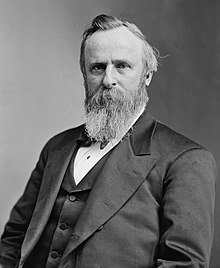
Back Rutherford B. Hayes Afrikaans ራዘርፎርድ ሄይስ Amharic Rutherford B. Hayes AN Rutherford B. Hayes ANG رذرفورد هايز Arabic رذرفورد هايس ARZ Rutherford B. Hayes AST Raterford Heys Azerbaijani رادرفورد بیرچارد هیز AZB Rutherford B. Hayes BCL
Rutherford B. Hayes | |
|---|---|
 Portrait, c. 1870–1880 | |
| 19th President of the United States | |
| In office March 4, 1877 – March 4, 1881 | |
| Vice President | William A. Wheeler |
| Preceded by | Ulysses S. Grant |
| Succeeded by | James A. Garfield |
| 29th and 32nd Governor of Ohio | |
| In office January 10, 1876 – March 2, 1877 | |
| Lieutenant | Thomas L. Young |
| Preceded by | William Allen |
| Succeeded by | Thomas L. Young |
| In office January 12, 1868 – January 8, 1872 | |
| Lieutenant | John Calvin Lee |
| Preceded by | Jacob Dolson Cox |
| Succeeded by | Edward Follansbee Noyes |
| Member of the U.S. House of Representatives from Ohio's 2nd district | |
| In office March 4, 1865 – July 20, 1867 | |
| Preceded by | Alexander Long |
| Succeeded by | Samuel Fenton Cary |
| Personal details | |
| Born | Rutherford Birchard Hayes October 4, 1822 Delaware, Ohio, U.S. |
| Died | January 17, 1893 (aged 70) Fremont, Ohio, U.S. |
| Resting place | Spiegel Grove State Park |
| Political party |
|
| Spouse | |
| Children | 8, including Webb C. Hayes and Rutherford P. Hayes |
| Parents |
|
| Relatives | Carl Edwards (great-great-great grandson) |
| Education | |
| Occupation |
|
| Signature | |
| Military service | |
| Branch/service | Union Army (USV) |
| Years of service | 1861–1865 |
| Rank | |
| Regiments | 23rd Ohio Infantry |
| Commands | Kanawha Division |
| Battles/wars | |
Rutherford Birchard Hayes (/ˈrʌðərfərd/; October 4, 1822 – January 17, 1893) was an American military officer and politician who served as the 19th president of the United States from 1877 to 1881.
As an attorney in Ohio, Hayes served as Cincinnati's city solicitor from 1858 to 1861. He was a staunch abolitionist who defended refugee slaves in court proceedings.[1] At the start of the American Civil War, he left a fledgling political career to join the Union Army as an officer. Hayes was wounded five times, most seriously at the Battle of South Mountain in 1862. He earned a reputation for bravery in combat, rising in the ranks to serve as brevet major general. After the war, he earned a reputation in the Republican Party as a prominent member of the "Half-Breed" faction.[2] He served in Congress from 1865 to 1867 and was elected governor of Ohio, serving two consecutive terms from 1868 to 1872 and half of a third two-year term from 1876 to 1877 before his swearing-in as president.
Hayes won the Republican nomination for president in the 1876 United States presidential election. In the disputed[3][4] general election, he faced Democratic nominee Samuel J. Tilden. Hayes lost the popular vote to Tilden; neither candidate secured enough electoral votes to win the election. Hayes secured a victory when a Congressional Commission awarded him 20 contested electoral votes in the Compromise of 1877. The electoral dispute was resolved with a backroom deal whereby both Southern Democrats and Whiggish Republican businessmen acquiesced to Hayes's election on the condition that he end both federal support for Reconstruction and the military occupation of the former Confederate States.[5][6]
Hayes's administration was influenced by his belief in meritocratic government and equal treatment without regard to wealth, social standing, or race. One of the defining events of his presidency was the Great Railroad Strike of 1877, which he resolved by calling in the US Army against the railroad workers. It remains the deadliest conflict between workers and strikebreakers in American history. As president, Hayes implemented modest civil-service reforms that laid the groundwork for further reform in the 1880s and 1890s. He vetoed the Bland–Allison Act of 1878, which put silver money into circulation and raised nominal prices, but Congress overrode his veto. His policy toward western Indians anticipated the assimilationist program of the Dawes Act of 1887. At the end of his term, Hayes kept his pledge not to run for reelection and retired to his home in Ohio. Historians and scholars generally rank Hayes as an average to below-average president.
- ^ "Rutherford B. Hayes". The White House. Retrieved May 19, 2021.
- ^ Welch, Richard E., Jr. (1971). George Frisbie Hoar and the Half-Breed Republicans, p. 91. Harvard University Press.
- ^ Robinson 2001, pp. 127–128.
- ^ Robinson 2001, pp. 182–184; Foner 2002, pp. 580–581.
- ^ ""Betrayal of the Freedman: Rutherford B. Hayes and the End of Reconstruction"". Rutherford B. Hayes Presidential Library & Museums. Retrieved May 19, 2021.
- ^ "America's Gilded Age: Robber Barons and Captains of Industry". Maryville Online. Retrieved February 21, 2022.
© MMXXIII Rich X Search. We shall prevail. All rights reserved. Rich X Search